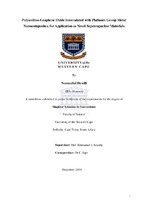Polyanilino-graphene oxide intercalated with platinum group metal nanocomposites, for application as novel supercapacitor materials
Abstract
Supercapacitors are one of the important subjects concerning energy storage which has proven to be a challenge in this country. Currently, the electrodes of most commercial supercapacitor are made of carbon which is known to be inexpensive and has high resistance to corrosion. These carbon based supercapacitors operate under EDLC. They offer fast charging/discharging rates and have the ability to sustain millions of cycles without degrading. With their high power densities, they bridge the gap between batteries which offer high energy densities but are slow in charging/discharging and conventional dielectric capacitors which are very fast but having very low energy densities. The objective of this work was to develop a high performance supercapacitor using polyanilino-graphene oxide intercalated with platinum group metal nanocomposites. Specific capacitance of each material was investigated with the objective of ascertaining the material that has the best capacitance. In this work, GO was functionalized with aniline and intercalated with Pt, Pd and Pd-Pt nanocomposites. The nanomaterials were characterized with FTIR, Ultravioletvisible (UV-visible) spectroscopy, high resolution scanning electron microscopy (HRSEM), high resolution transmission electron microscopy (HRTEM), energy dispersive x-ray microanalysis (EDS) and X-ray diffraction (XRD) analysis. The composites were tested for possible application as supercapacitor materials using potentiostatic-galvanostatic constant current charge/discharge. The synthesized materials had good electronic, mechanical, optical, physical etc. properties as proven by the various characterization techniques but they proved not to be ideal for application as supercapacitor materials. The materials tested negative when tested for both anodic and cathodic materials therefore we can conclude that the materials are not good supercapacitor materials and therefore cannot be used in application as novel as supercapacitors.

